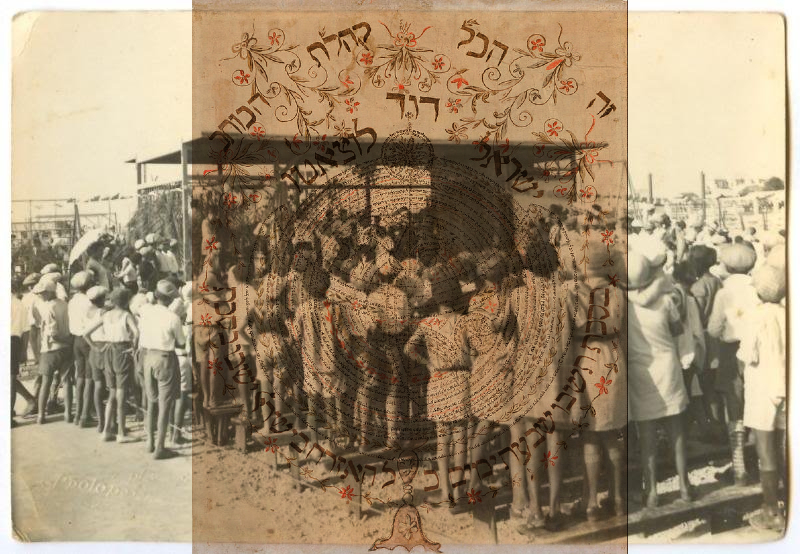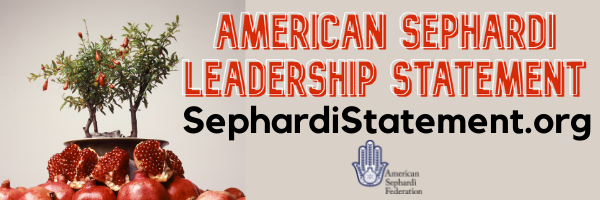
!חג שמח
From your friends at
The American Sephardi Federation
In honor of Sukkot, the ASF’s Sephardi World Weekly is pleased to present the following “Letter from the Land of Israel”:
The prophet Amos transmitted God’s promise of future redemption through an unexpected image: “On that day, I will raise the fallen Sukkah of David” (Amos 9:11).
At first glance, one might wonder if perhaps Amos misspoke. The traditional name for the line descending from David is “the House of David,” not “the Sukkah of David.” But Amos didn’t misspeak. What, then, was the meaning of his image?
A Sukkah is the temporary dwelling with an organic, latticework ceiling (the sages want you to be able to see the stars) that Jews build and live in during the seven-day holiday of Sukkot, the festival commemorating the forty years that the Jewish people dwelled in the desert after leaving Egypt. Every year the Jewish people relives the sacred history of its founding generation: on Pesach we leave Egypt, on Shavuot we receive the Law at Sinai, and during Sukkot we dwell in our desert booths.
As for David, he’s the sweet singer of Israel, the young superstar shepherd who killed Goliath, was anointed King, and established God’s musical rule in a Holy City. His son, Solomon, transformed that city, Jerusalem, into the home of what scholars call “Solomonic humanism,” a spiritual-cultural ideal that embraced “enlightenment, adoption of an educational ideal, cultivation of the individual, attention to rhetoric [and] new interest in the natural sciences.”
This is a scholarly articulation of an ideal similar to what animated Rishon LeZion Rabbi Ben-Zion Meir Hai Uziel’s vision of Israel’s teudah, meaning goal or mission: “Judaism’s mission [teudah] is nothing less than the exalted aspiration to elevate humanity… to the highest level of human perfection,” including the “scientific… artistic, economic and aesthetic” dimensions of life, so long as these actions are undertaken “for the sake of heaven.”
So what’s the connection between David and Sukkot?
Continue reading below…
~~~~~~~
Together, we can go from strength to strength in the New Year!

With your generous, tax-deductible donation, the ASF can cultivate and advocate, preserve and promote, as well as educate and empower!
For more information about sponsorship opportunities: email or leave a message at 212.294.8350. To donate by mail, please send a check payable to “American Sephardi Federation,” 15 W 16th St., New York, NY, 10011
Email us at info@americansephardi.org if you are interested in discussing donating securities or planned giving options with a financial professional from AllianceBernstein.
~~~~~~~
David and Sukkot seem to exist at opposite poles of Jewish history: the founding of the monarchy in Jerusalem versus the generation of the desert.
David’s Kingdom and all that it represents, the political regime whose mandate is to cultivate human powers in gratitude to the Creator of those powers, no longer exists. Amos, however, offers hope. It’s not a house, it’s a Sukkah, the Sukkah of David: temporary, but always capable of being reconstituted because the vision of David’s regime remains, the teudah rearticulated in our time by R’Uziel retains its power and validity. And, therefore, even if David’s kingdom doesn’t presently exist, David’s Sukkah, the man-made temporary dwelling that points beyond itself to the heavens, like a king pointing beyond himself to a higher Power, was never destroyed, was never obliterated, and was never annihilated. It’s only fallen.
During the holiday of Sukkot, we add a sentence to the blessing after meals, a mini-riff offered in response to Amos’ original prophecy: “The Compassionate One, may He raise for us the Fallen Sukkah of David.” The mini-riff on Amos was then transformed into the audacious request addressed directly to God and composed last century by R’Yosef Chayim of Baghdad, aka the Ben Ish Hai (1835-1909), Yah et Sukkat David Taqim (“Lord, Raise David’s Sukkah”).
In his piyyut, R’Yosef Chayim enumerates the seven honored guests who are traditionally welcomed into the Sukkah during the seven-day holiday and asks that the Jewish people be redeemed in their merit, from Avraham, Yitzchaq, Ya’aqov, Moshe, Aharon, and Yosef until, on the seventh night, and in the concluding seventh verse of the piyyut, King David.

Finally, a few days ago, in honor of Sukkot, the great contemporary Iraqi-Israeli payytan, musician, and scholar, R’David Menachem, posted on YouTube a wonderful performance of a beautiful new melody that he composed in an Andalusian-Aleppo-style for R’Yosef Chayim’s piyyut, Yah et Sukkat David Taqim.
The American Sephardi Federation is very happy to share with our readers this holiday message and a wonderful, new melody for a song based on Amos’ 2,800-year-old image of the future: may the Compassionate One raise for us the fallen Sukkah of David!
Haj Sukkot Sameah!
The American Sephardi Federation

~~~~~~~
Banner image credit: Israel David Luzzatto’s Sukkah decoration, a micrographic drawing of Kohelet (Ecclesiastes) evoking the movements of the sun, Triste, Italy (Scan courtesy of Google Arts & Culture – The H. Ephraim & Mordecai Benguiat Family Collection, The Jewish Museum; See also: The Posen Library of Jewish Culture and Civilization, Volume 6, p. 389),1775, superimposed over a photograph by Avraham Suskin of a Sukkah being built, Tel Aviv, Mandatory Palestine (Photo courtesy of pitzkale/Ebay), circa 1920s
~~~~~~~

The American Sephardi Federation invites all individuals, communities, and organizations who share our vision & principles to join us in signing the American Sephardi Leadership Statement!
~~~~~~~
Upcoming Events or Opportunities
The ASF Institute of Jewish Experience presents:
Exclusive Authors Series with Judith Roumani
Join us for this episode of our Exclusive Authors Series with Judith Roumani discussing her new book Francophone Sephardic Fiction: Writing Migration, Diaspora, and Modernity.
Tuesday, 25 October at 12:00PM EST
(Complimentary RSVP)
Sign-up Now!

About the book:
Francophone Sephardic Fiction approaches modern Sephardic literature in a comparative way to draw out similarities and differences among selected francophone novelists from various countries, with a focus on North Africa. The definition of Sepharad here is broader than just Spain: it embraces Jews whose ancestors had lived in North Africa for centuries, even before the arrival of Islam, and who still today trace their allegiance to ways of being Jewish that go back to Babylon, as do those whose ancestors spent a few hundred years in Iberia. The author traces the strong influence of oral storytelling on modern novelists of the twentieth and early twenty-first centuries and explores the idea of the portable homeland, as exile and migration engulfed the long-rooted Sephardic communities.
About the author:
Judith Roumani is founder and director of the Jewish Institute of Pitigliano, and founder and editor of the online journal Sephardic Horizons, which appears three times a year. She received a BA Honors in Spanish and French from the University of Nottingham, an MA in Latin American Studies from the University of London, and a Ph.D. in Comparative Literature from Rutgers. She has taught Spanish and Sephardic studies at the University of Maryland, College Park, and other colleges in the Washington DC area. She has also been a director of publications, professional translator, an associate editor or author of five books and a monograph, and her work has been translated into Hebrew, Italian, and French.
Click here for more about the book.
Sponsorship opportunities available:
~~~~~~~
The American Sephardi Federation, the Seattle Jewish Theatre Company, and the Sephardic Jewish Brotherhood of America present:
“ARRIVALS”
A Jewish Romeo & Juliet love story based on historical events.
A hit in Seattle, coming to New York.
(Written and Directed by Art Feinglass)
When the first Sephardic Jew arrived in Seattle in 1902, not everything went as planned. Marco Cordova, a young Sephardic Jew from Turkey, came to America to make his fortune. Bayla Keigelman, a fragile Ashkenazi girl from Russia, arrived fleeing a pogrom. Their meeting seemed written in the stars until tradition declared their love forbidden.
Sunday, 30 October at 3:00 PM EST
Tuesday, 1 November at 8:00 PM EST
Thursday, 3 November at 8:00 PM EST
Sunday, 6 November at 3:00 PM EST
Sign-up Now!
$36 Early bird discount (if purchased before October 9th)
$50 Ticket price (if purchased after October 9th)
The Center for Jewish History
15 W 16th Street
New York City

“Arrivals tells the Sephardic story with great drama, humor and warmth.”
Rabbi Simon Benzaquen, Congregation Ezra Bessaroth, Seattle, WA
“Everyone in the audience was engaged and enjoyed the show.”
Aaron Petersen, President , Temple Beth El, Tacoma, WA
“A tour de force!”
Rabbi Emeritus James Mirel, Temple B’nai Torah, Bellevue, WA
Sponsorship opportunities available:
~~~~~~~
The ASF Institute of Jewish Experience presents:
Exclusive Authors Series with Andrée Aelion Brooks and Ruth K. Abrahams
Join us for an episode of our Exclusive Authors Series with Andrée Aelion Brooks and Ruth K. Abrahams discussing her book The Remarkable Life of Luis Moses Gomez.
Tuesday, 1 November at 12:00PM EST
(Complimentary RSVP)
Sign-up Now!

About the book:
During the early days of colonial America, a number of Sephardic Jews and conversos came from the Caribbean islands to the eastern seaboard for economic opportunity. They have largely been overlooked as the stories of the later German and Ashkenazi Jewish immigrants, took over in terms of numbers and achievements. Here is the story of one of those early Sephardic settlers who came from Jamaica to the New York area in search of such opportunities.
About the authors:
Andrée Aelion Brooks is a journalist, author and lecturer specializing in Jewish history. Formerly a contributing columnist for the New York Times, she is an Associate Fellow, Yale University, and founder of the Women’s (political) Campaign School at Yale. Her award-winning books include a comprehensive biography of Dona Gracia Nasi, a Jewish leader who was the richest woman in Renaissance Europe; Russian Dance, about a Jewish Bolshevik spy; Out of Spain, a children’s program in Sephardic history. She was honored in 2013 by the Connecticut Women’s Hall of Fame.
Executive Director of the Gomez Mill House Foundation from 1999-2017, Dr. Ruth Abrahams also served as Executive Director of the Lehman College Foundation and Vice President for Advancement at Pratt Institute. Artistically, Dr. Abrahams sang professionally in New York from 1967-1980. She received an M.A. in Humanities (Japanese Studies), and a Ph.D. in Dance History from New York University, where she taught as adjunct associate professor from 1982-1996. She was a founding member and first president of World Dance Alliance-Americas, an international advocacy organization for dance.
Click here for more about the book.
Sponsorship opportunities available:
~~~~~~~
The ASF Institute of Jewish Experience presents:
Exclusive Authors Series with Sarina Roffé
Join us for an episode of Exclusive Authors Series with Sarina Roffé as she discusses her book Branching Out from Sepharad.
Tuesday, 15 November at 12:00PM EST
(Complimentary RSVP)
Sign-up Now!

About the book:
In Branching Out from Sepharad, readers will follow the history of Jewish life in Hispania, Spain, the Middle East and the Americas as Sarina Roffé links three rabbinic dynasties from the 11th Century to the present day, all with an Irish Converso Twist.
About the authors:
Sarina Roffé is a professional genealogist, editor of the journal DOROT, and founder of the Sephardic Heritage Project. She is the author of Branching Out From Sepharad (Sephardic Heritage Project, 2017), which outlines the history of Jews in Spain, the 1492 expulsion, their history in Syria, and their immigration to the Americas. She is Co-Chair of the Brooklyn Jewish Historical Initiative, and Chair of the JewishGen Sephardic Research Division.
Sarina is also the author of Backyard Kitchen: Mediterranean Salads, Backyard Kitchen: the Main Course, and a cooking app called Sarina’s Sephardic Cuisine, available in the Apple Store, as well as hundreds of articles. Sarina presents often at IAJGS Conferences and has completed over a dozen genealogies, through her genealogy consulting business, Sephardic Genealogical Journeys.
Click here for more about the book.
Sponsorship opportunities available:
~~~~~~~
ASF Broome & Allen & ADL Collaborative for Change Fellow Isaac de Castro presents:
Entre Diasporas: Telling the Latin-American Jewish story. Contando la historia judía latinoamericana

Tell your story. Cuenta tu historia.
We’re looking for first-generation Latino Jews in the United States who immigrated because of political and social turmoil. Jews of Sephardic descent from Colombia, Cuba, and Venezuela that now reside in the Miami area will be given priority, but others are welcome to apply as well.
Fill out this form to be considered as an interviewee for this project. After you’ve submitted, we will be in touch promptly to set up a preliminary phone call.
Click here for more information.